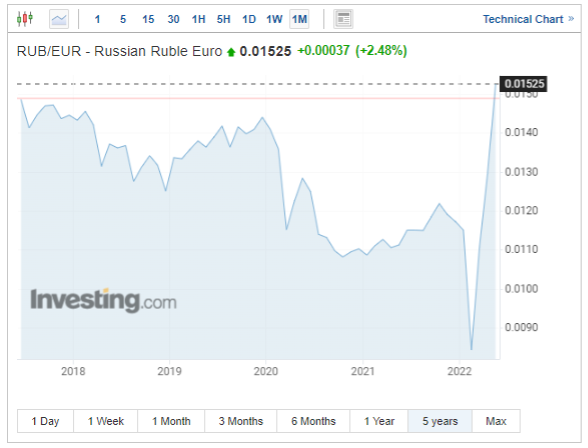Price growth is fast
For comparison, back in March, the year-on-year rise in prices in Russia was 16.69 percent. Looking at the month-on-month rise in consumer prices, we can see that the rise in prices has been the highest since January 1999, when in March 2022 it reached 7.61 percent. It then slowed sharply to 1.56 per cent in April.
Steps to curb inflationary pressures
The annual inflation rate is well above the Russian central bank's target set at 4 percent. Shortly after Russia's invasion of Ukraine, the local central bank more than doubled the key interest rate to 20 percent from the initial 9.5 percent in order to curb inflationary pressures and support the ruble's exchange rate. The Russian currency plunged to an all-time low in March after Western states condemned the incursion of troops into Ukraine and imposed a raft of sanctions against Russia. The bank now forecasts that inflation could reach a level of between 18 and 23 percent later this year. In order to support the economy, it has also reduced the base interest rate from the aforementioned 20 per cent to 14 per cent.
Ruble quickly recovered from the fall
Despite a significant fall in the Russian currency shortly after the outbreak of the war in Ukraine, the value of that currency has recovered relatively quickly from the historic lows it reached in the first days since the beginning of the military campaign. According to European Central Bank data, the value of the ruble stood at 117.2 rubles per euro on March 1, 2022, down nearly 67 percent from the previous period.* However, during last week's Friday trading day, the ruble's value against the euro reached five-year highs due to a number of factors. Consumers began to buy more staple foods and other goods, fearing that prices would rise even more sharply. Not to mention that demand for US dollars and euros is falling due to restrictions on cross-border transactions and a slump in imports from Russia. The ruble exchange rate is also supported by the fact that export companies have to sell their earnings in this currency.
Western states hoped that the sanctions imposed on Russia and the associated weakening of the Russian currency would prevent Putin from financing the war. Investors have no choice but to wait for the situation to develop.

Development of the value of the RUB / EUR currency pair over the last 5 years (Chart: Investing.com)
* Past performance is no guarantee of future results.
Olivia Lacenova, analyst at licensed company Wonderinterest Trading Ltd.